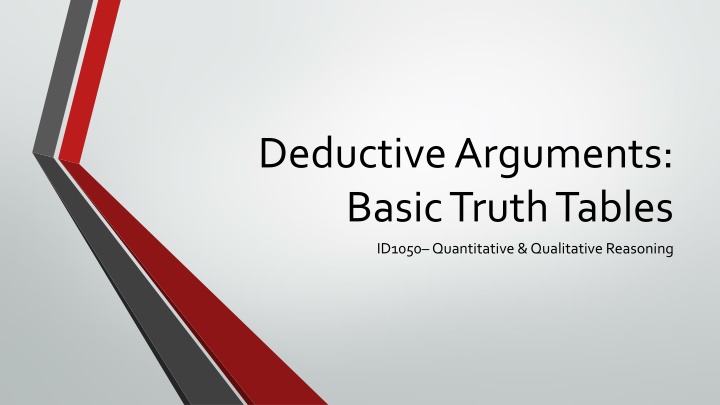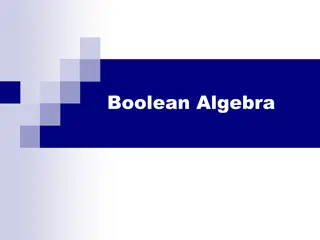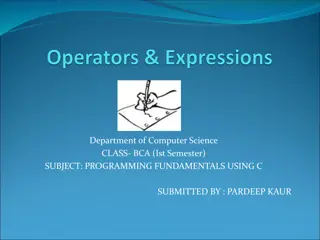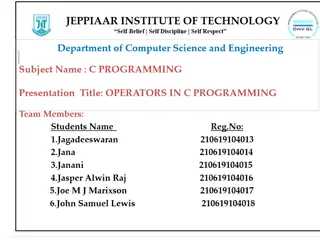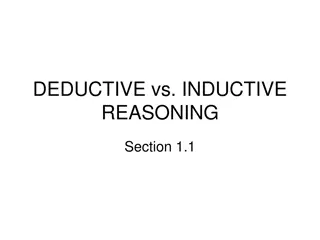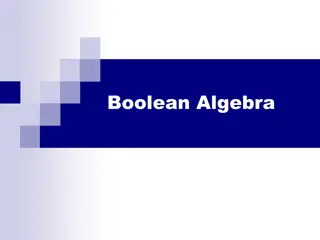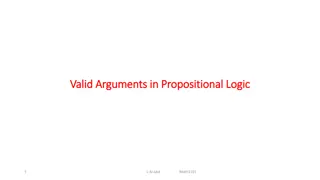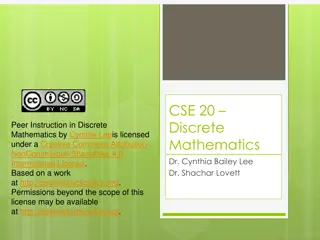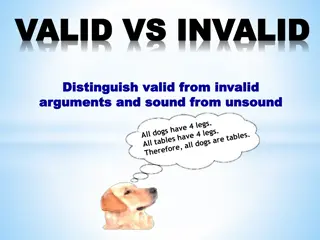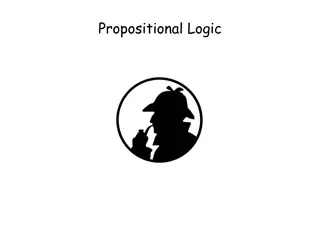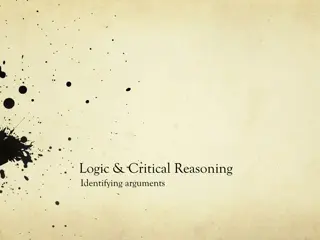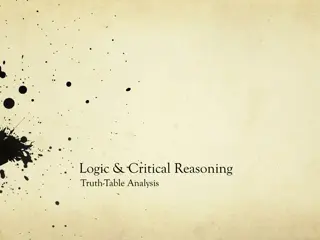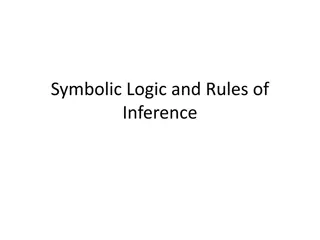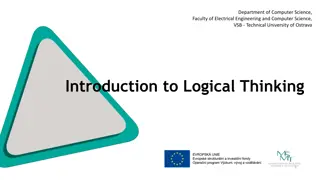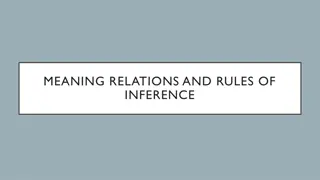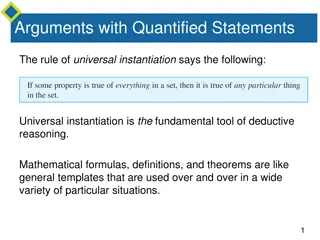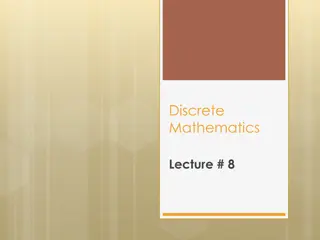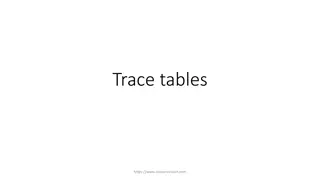Deductive Arguments: Truth Tables for Logical Operators
In deductive reasoning, truth tables are used to determine the validity of compound statements formed from simple statements using logical operators. By listing all possible values and outcomes, we can analyze the truthfulness of statements like AND, OR, and IF...THEN. Explore the concepts with examples involving pizza and quiche lunch choices.
Uploaded on Feb 26, 2025 | 3 Views
Download Presentation

Please find below an Image/Link to download the presentation.
The content on the website is provided AS IS for your information and personal use only. It may not be sold, licensed, or shared on other websites without obtaining consent from the author.If you encounter any issues during the download, it is possible that the publisher has removed the file from their server.
You are allowed to download the files provided on this website for personal or commercial use, subject to the condition that they are used lawfully. All files are the property of their respective owners.
The content on the website is provided AS IS for your information and personal use only. It may not be sold, licensed, or shared on other websites without obtaining consent from the author.
E N D
Presentation Transcript
Deductive Arguments: Basic Truth Tables ID1050 Quantitative & Qualitative Reasoning
Basic Truth Tables A compound statement is formed from simple statements combined using logical operators. The compound statement is either True or False, depending on the logical combination of its simple statements and whether they are True or False. This means we can go through all the possibilities of each simple statement being True or False and check whether the compound statement is Trueor False. Listing the rows of possible values of the simple statements and the resulting value of the compound statement is called forming a truth table. We will begin this process with forming the truth tables for the basic logical operators AND, OR, and IF THEN... Using these tables, we can form truth tables for more complicated statements.
Setting Up the Truth Table If there are two variables, each of which can have two possible values (T or F), our table with have four rows. The order of the rows isn t critical since each row is independent of the others, but the rows are usually presented in the standard order shown. It helps to have a concrete example to illustrate these abstract concepts. I ll use the idea of having two foods (pizza and quiche) available for lunch to explain the values of the basic truth tables. In the following slides, let the variables p and q represent these statements: p= I ll have pizza for lunch. q= I ll have quiche for lunch. p q [Binary logical statement] T T T F F T F F
Truth Table for AND Let s say that one day I make the statement I ll eat pizza and quiche for lunch . You follow me and see that I do have both pizza and quiche for lunch. In this case, the statement I made was True. In row 1, in which p=Tand q=T, the statement p q is True. On another day, I make the same statement: I ll eat pizza and quiche for lunch . You follow me and see that I eat pizza, but not quiche. In this case, the statement I made was False. In row 2, in which p=Tand q=F, the statement p q is False. On yet another day, I make the same statement. You follow me and see that I eat quiche, but not pizza. In row 3, in which p=Fand q=T, then the statement p q is False. Finally, after making the same statement, I eat neither pizza nor quiche. Row 4 (both p and q are F) for the statement p q is False. This completes the truth table for ANDin all cases of p and q being Tor F. p q p q p q p q p q p p p p p q q q q q T T T T T T T T T T T T T T T T T T T F F F F F F F F F F F F F T T T T T F F F F F F F F F F F F F
Truth Table for OR Let s say that one day I make the statement I ll eat pizza or quiche for lunch . I do have both pizza and quiche for lunch. The statement I made was True. For row 1, p q is True On another day, I make the same statement: I ll eat pizza or quiche for lunch . I had pizza but not quiche, but the statement I made was still True. For row 2, p q is True On a third day, I make the same statement. This time I have quiche and not pizza. The statement I made was still True. For row 3, then, p q is True again. On a fourth day, I make the same statement. I have neither pizza nor quiche for lunch. The statement I made is finally False. For row 4, p q is False This completes the truth table for inclusive OR in all cases of p and q being T or F. p q p q p q p q p q p p p p p q q q q q T T T T T T T T T T T T T T T T T T T F F F F F T T T F F F F F T T T T T T T F F F F F F F F F F F
Truth Table for IF..THEN.. Let s say that one day I make the statement If I eat pizza for lunch, then I ll have quiche . This is saying that eating pizza will be followed by eating quiche. I have pizza and quiche for lunch. Eating pizza was followed by eating quiche. For row 1, p q is True. On another day, I make the same statement. I have pizza but not quiche. Eating pizza was not followed by eating quiche. For row 2, p q is False. On a third day, I make the same statement. I don t have pizza, but I do have quiche. Now this one is tricky. Is the statement I made True or False? I didn t have the pizza, so you can t check to see if eating pizza is followed by eating quiche or not. In the case where we can t check, we give the speaker the benefit of the doubt, and assume they told the truth. So, for row 3, p q is True. On a fourth day, I again don t have pizza, nor do I have quiche. Again, you can t check to see if eating pizza is followed by eating quiche or not. Giving the benefit of the doubt again, for row 4, p q is True. This completes the truth table for IF..THEN..in all cases of pand q being Tor F. p q p q p q p q p q p p p p p q q q q q T T T T T T T T T T T T T T T T T T T F F F F F F F F F F F F F T T T T T T T F F F F F F F F F F T
Unary NOT operator The NOT operator acts on a single variable. NOT is like the negative sign in arithmetic. It changes False to Trueand True to False. Since there is only a single variable, there are only two rows in our truth table, corresponding to the variable being True or False. Assume I make the statement I won t have pizza for lunch. If I do have pizza for lunch, I made a Falsestatement. Row 1 for p is False. If I don t have pizza, I made a True statement. Row 2 for p is True. p p T F F T
Visualizing Truth Tables We can use a 2-circle Venn diagram to illustrate the information in our truth tables. The circle on the left represents the quality p and the circle on the right represents the quality q . The intersection represents having both qualities, and the exterior represents having neither quality. We ll use a filled region to represent True, and an unfilled region to represent False. There are four distinct regions, each representing one row in our two-variable truth table. With four regions, each of which can be filled or unfilled, there are 16 possible combinations, all of which represent a logical statement consisting of AND, OR, IF..THEN.., and NOT and their combinations. We will only look at a few of the interesting ones. p q False True 2 1 3 4
Shading the Venn Diagram Here is our truth table for AND, with row numbers added. Only row 1 is True, so only region 1 is shaded in the diagram. Visually, this represents the part of both circles that has both quality p and quality q , which is what AND means. Here is our truth table for OR. The first three rows are True, so the first three regions are shaded. Visually, this represents the fact of having either quality p , quality q , or both qualities. This is also sometimes called union , which explains the symbol U . 2 1 3 4 p q p q Row p q p q 1 T T T T T T 2 T F F T F T 3 F T F F T T 4 F F F F F F
Truth Tables and Their Diagrams 2 1 3 The IF..THEN.. truth table is here, along with its Venn diagram. It is not obvious what the diagram should look like before building the table and shading in the proper rows. Note the lack of symmetry, which is unlike the diagrams for AND and OR. Recall that order is important for the IF..THEN.. statement, but is not for AND and OR. The table and diagram for the statement p . The table and diagram for the statement ~p . 4 p q p q p q p p q ~p T T T T T T T T F T F F T F T T F F F T T F T F F T T F F T F F F F F T
More Truth Tables, More Diagrams Here are some other interesting diagrams and tables we haven t seen yet. The exclusive or (XOR) table and diagram. (The symbol is .) The p but not q table and diagram. The neither p nor q table and diagram. p ~q p q ~(p q) p q p q p q T T F T T F T T F T F T T F T T F F F T T F T F F T F F F F F F F F F T
Conclusion Here is a combined truth table for the three binary logical operators AND, OR, and IF..THEN... AND is only True if both of its simple statements are True. OR is only False if both of its simple statements are False. IF..THEN.. is only False for row p=T, q=F. Here is the truth table for unary logical operator NOT. The NOT operator switches True to False and False to True. Venn diagrams can be used to visualize this information. p q p q p q p q T T T T T T F F T F F T F T T F F F F T p p T F F T
